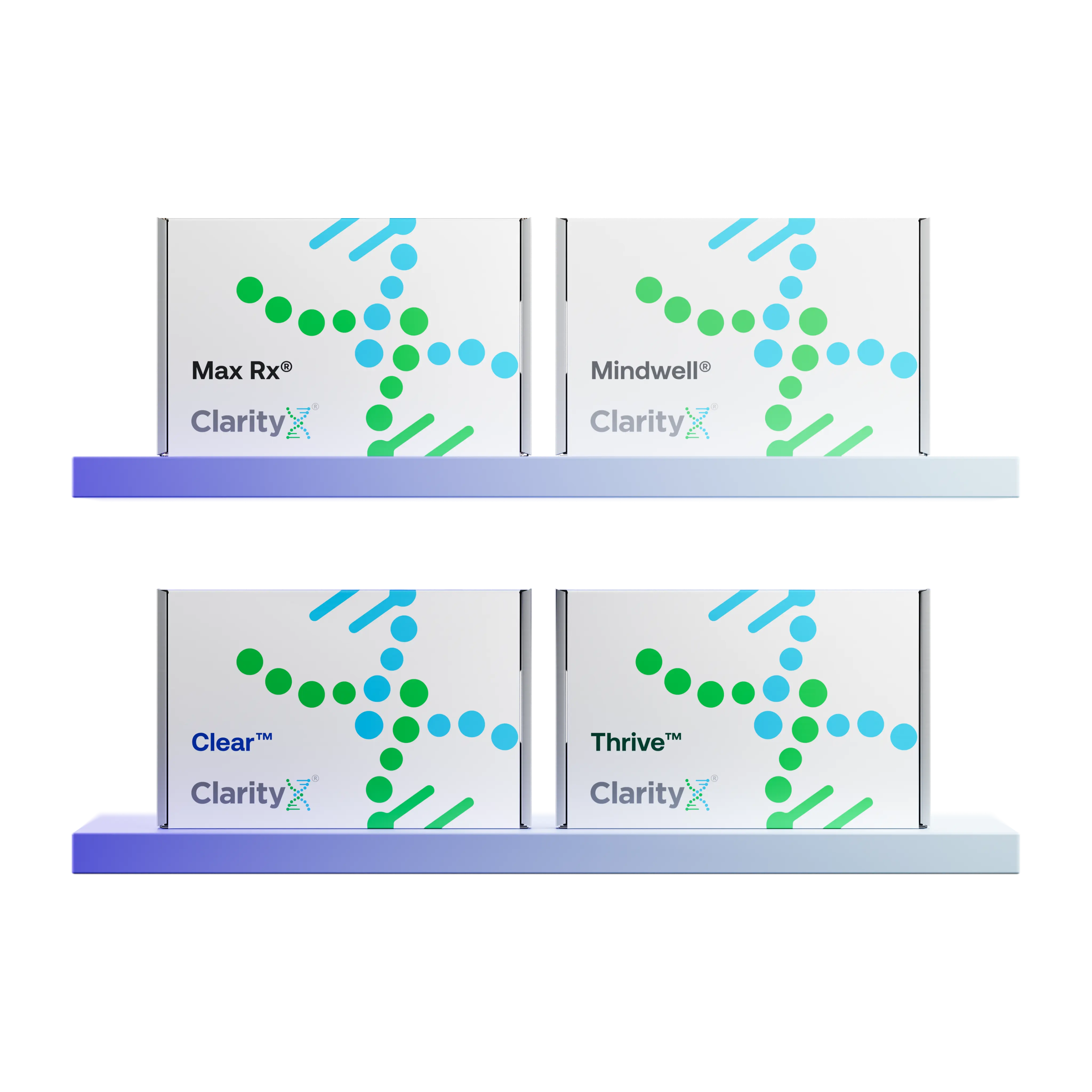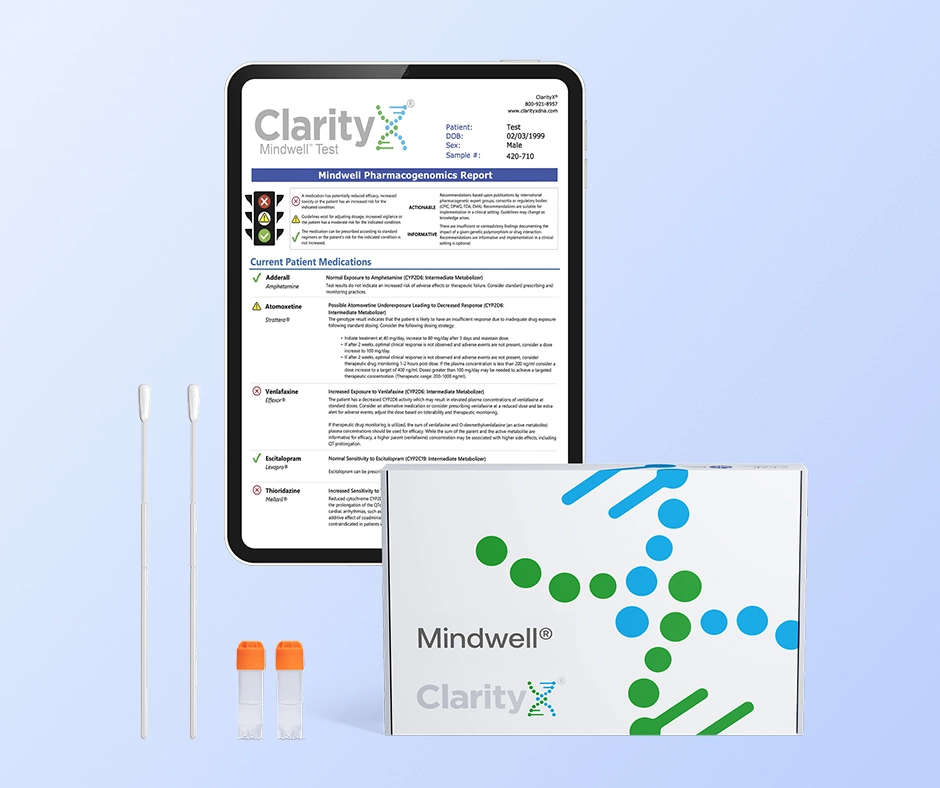Key Takeaways
- No medication is 100% risk-free during pregnancy. Every decision requires a careful risk-benefit conversation with your healthcare provider.
- Your personal risk from a medication is not universal. It is heavily influenced by your unique genetic makeup, specifically the genes that control how your body metabolizes drugs.
- Pharmacogenetic (PGx) testing is a science that analyzes these genes to predict how you will respond to a medication, helping to identify which drugs may be ineffective or cause a higher risk of side effects for you.
- A ClarityX test provides a personalized medication roadmap, empowering you to have a data-driven conversation with your doctor to make the safest, most informed choices for you and your baby.
For an expectant mother, every choice is made with the health and well-being of her developing baby in mind. From diet to lifestyle, countless decisions are weighed and considered. Few choices, however, are as fraught with anxiety and uncertainty as the decision to take medication during pregnancy. Whether it's for a pre-existing chronic condition, a common cold, or a mental health concern, the question remains the same: "Is this safe?"
The truth is, no medication is considered 100% risk-free during pregnancy. Every decision is a careful balance of risk versus benefit, a conversation that must be had between a patient and their healthcare provider. The goal is not to avoid all medications, but to make the most informed, personalized, and safest choice possible. This guide will explore the landscape of medication risk in pregnancy, from well known dangers to the nuanced decisions required for common drugs, and introduce a new frontier in safety: how your personal genetics can help de-risk the entire process.
The Evolution of Safety Labels: From Letters to Narratives
For many years, the FDA used a simple letter-grade system (A, B, C, D, and X) to classify the risk of medications in pregnancy. While seemingly straightforward, this system was often misinterpreted and failed to capture the complexity of risk. A drug in Category C, for example, could be there because of concerning animal studies or simply because no human studies had been done. This lack of context was not helpful for nuanced decision making.
In 2015, the FDA phased out this system in favor of the Pregnancy and Lactation Labeling Rule (PLLR). The current standard requires drug labels to provide a more detailed, narrative description of the available data, including:
- Pregnancy Exposure Registry: Information on registries that collect data on a drug's effects on pregnant women.
- Risk Summary: A detailed summary of the risks to the developing fetus, and what is known from human and animal studies.
- Clinical Considerations: Information to help providers make prescribing decisions, including the risks of the untreated maternal disease.
This shift reflects a modern understanding that risk is not a simple letter grade but a complex spectrum that requires careful, individualized assessment.
Medications with Well-Established, Significant Risk
Some medications are known teratogens, meaning they have been proven to cause birth defects, and are generally avoided during pregnancy unless absolutely necessary for the mother's survival. Understanding these high-risk categories is a critical first step in medication safety.
Medications Requiring Careful Risk-Benefit Analysis
Many medications fall into a gray area where the risk of the untreated maternal condition may be greater than the potential risk of the medication itself. Untreated depression, for example, can lead to poor self-care, malnutrition, and postpartum complications. In these cases, a thorough discussion with a doctor is essential.
A New Frontier in Safety: The Genetic Factor
The critical question that remains is: why does one person take a medication with no issue, while another experiences a negative outcome? The answer often lies in our DNA. This is where the conversation ties directly to the value of pharmacogenetic (PGx) testing.
The level of risk from these medications is not the same for everyone. A person's unique genetic makeup, specifically the genes that control their drug metabolizing enzymes plays a crucial role. When you take a medication, your body's enzymes are responsible for processing it, activating it, and eventually clearing it from your system. Common variations in the genes that create these enzymes can dramatically alter how you respond to a drug.
For example:
- If an expectant mother is a "poor metabolizer" for the enzyme that clears a certain antidepressant, a standard dose could lead to unusually high concentrations of the drug in her bloodstream.
- This increased drug exposure could, in turn, potentially increase the exposure and risk for the developing fetus.
Conversely, if she is an "ultra-rapid metabolizer," her body might clear the drug so quickly that it provides no therapeutic benefit, leaving her underlying condition untreated.
A ClarityX® test provides this critical data layer. It helps a doctor understand a patient's individual metabolic capacity before prescribing. This allows them to make a more informed, data-driven decision, either by choosing a medication that uses a different, safer pathway for that specific patient or by adjusting the dose to a level that is appropriate for their unique genetic profile. This moves the safety conversation from a general warning to a truly personalized risk assessment.
Empowering Your Pregnancy Journey with Personalized Data
Pharmacogenetic testing is not about creating fear; it's about providing clarity and confidence. The process is simple—a non-invasive cheek swab done at home—but the information it provides is profound. The results are delivered in a clear, easy-to-understand report designed to be shared with your doctor.
This data empowers you to become an active participant in your healthcare. You can move beyond general questions to have a specific, data-driven conversation about what is right for your body.
Questions to Discuss with Your Doctor, Empowered by PGx Testing:
- "My genetic report shows I am a poor metabolizer for the pathway this drug uses. Should we consider a lower starting dose?"
- "Are there alternative medications for my condition that do not use this high-risk pathway identified in my report?"
- "How does this genetic information change our treatment plan to ensure the safest possible outcome for my baby?"
Conclusion
Navigating medication choices during pregnancy will always require careful consideration and expert medical guidance. However, we no longer have to rely on a "one-size-fits-all" approach. The advent of pharmacogenetic testing represents a new standard of care, allowing for a level of personalization that was previously impossible.
By understanding your own genetic blueprint, you can work with your doctor to de-risk the process, minimize the chance of side effects, and choose the most effective treatment for you. This proactive, data-driven approach provides peace of mind and empowers you to make the safest, most informed decisions for both you and your baby.
References:
https://my.clevelandclinic.org/health/articles/24325-teratogens
https://clarityxdna.com/blog/learn/pharmacogenetic-testing-unlocking-personalized-medicine/
https://clarityxdna.com/products/max-rx
https://clarityxdna.com/blog/how-long-does-xanax-r-take-to-work-explained/






